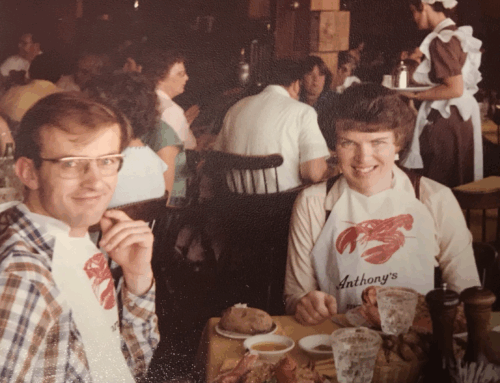By Carolyn Campbell
It’s easy to start eating without thinking much about it. High-calorie food temptations become even more tempting when you’re hungry, stressed, or tired. Before you know it, it’s easy to gobble down one cookie… two…or five! It seems like a popcorn bowl has your name on it. You might leave the grocery store with a candy bar that wasn’t on your grocery list. Dian Thomas, author of the book, “Tipping the Scales in Your Favor” names a few common high-calorie pitfalls and offers the following suggestions for avoiding them.
1 Nibbling while preparing food: It’s possible to consume a whole meal just by tasting and nibbling before you ever sit at the dinner table. “Chewing sugar-free gum while I prepare a meal makes me think twice about tasting the food,” says Thomas. Instead, dip a spoon in the pot to taste for flavor while cooking and sample only what clings to the spoon.
2. Finishing off leftover food while cleaning up after dinner.
Finishing off food left on a plate or in a serving dish while clearing the table is a common mistake. Instead, please don’t eat anything after you have finished your meal. You could assign family members to take turns with the cleanup. Remember the saying, “It’s better for extra food to go to waste rather than to add inches to your waist.” Chewing gum after you finish your meal may help.
3. After dinner eating
“After dinner, I would often sit in my kitchen watching television, thinking what I could eat next,” says Thomas. This is when I would bring out the ice cream, and I seldom stopped with a small scoop. So I kicked the TV out of the kitchen and began to plan urgent tasks elsewhere, taking my mind off eating.” Many times we eat because we are bored, not because we are hungry.
4. Family birthday parties
“When my extended family gets together for a birthday party, there’s always cake and ice cream,” says Thomas. “Neither of those treats is on my food plan. Occasionally, I’ll have a spoonful if the ice cream is homemade or extra-special. But more often, I’ll spoon fruit over cottage cheese instead. My newest concoction is a cottage cheese “sundae” with a sauce made from unsweetened raspberries. I put one-half cup of nonfat cottage cheese in a lidded plastic container I can take with me. Then I pour one-half cup of the sauce on top and add one tablespoon of chopped almonds. The total calories are under 200, and I feel delighted after eating it.”
5. Group eating events
Potluck dinners, office parties, and meetings where snacks are on hand can be diet-deadly without a plan. To succeed, do a little preparation. “First, I try to find out what will be served in advance, and then I put an alternate plan in place,” Thomas explains. “For a long time, I belonged to an organization that served pizza at a monthly event. Every time I attended, I packed a healthy dinner in a small cooler, usually a salmon sandwich with fruit and vegetables on the side. People would walk by and say, ‘I sure wish I had that for dinner.’”
6. The temptation to stop for ice cream.
Like many people, Thomas says this used to be a favorite pastime of hers. “I would drive by my local ice cream shop, and it would seem to say, ‘Dian, I have a wonderful shake waiting for you.’” Since that’s off-limits for her now, she found a replacement–a frozen banana smoothie. She says, “I let a bunch of bananas ripen until there are just a few brown spots. Peel them, cut them into 1-inch sections, and freeze them in Ziploc bags until you are ready to make your shake. (Freeze one banana per bag.) To make the shake, combine one frozen banana, 2 ½ cups skim (soy, rice, or almond milk are also good), and ½ teaspoon vanilla in a blender and blend until smooth and creamy. One serving is less than 200 calories.
7. Energy drop while running errands.
While running errands, Thomas used to whip into McDonald’s and pick up a cheeseburger for a dollar. Sometimes she even ate two. No more. Now she packs a car snack kit with bottled water and several 150-calorie snacks. “That way, when I have an energy drop, I reach into my small cooler and grab a bag. My energy level is soon back to normal without the guilt or calories.” Thomas uses Ziploc sandwich bags to store snacks, and she always packs nonperishable snacks. “Taking snacks with me also keeps me from having an all-blowout meal as soon as I get home.”
8. Fast food feeding
Today, Thomas feels that eating fast food while running errands “was one of the chief ways I packed on the pounds. No more fast food on the road for me.” She now has a “fast food restaurant” in her car, equipped to fill her up for a quick snack or a light meal. “All I have to do is pull off the road and open my cooler filled with pre-portioned healthy ‘fast food’ designed for my now-leaner body.” You can also set this up to satisfy hungry kids while running errands or on road trips. A favorite fast-food snack is ten almonds and two tablespoons of raisins. “For a light meal, I have a small can of salmon (don’t forget a small can opener) and ten whole wheat Triscuits, which give me a little more energy,” says Thomas. To set up fast food in your car, use a container that will fit snugly without sliding around in the car interior or trunk. Then make a list of combinations of healthy, nonperishable foods you can eat on the go. Next, portion your food into packages, so they’re quick and easy to pull out and eat. Otherwise, you could have a “blowout” and consume the whole bag. Ziploc sandwich bags work well to hold about 150 calories per snack. “Even though the bag can hold more, I limit the contents to the portion size I need,” says Thomas. “Just think of the money you will save and the health benefits you will enjoy in your own “fast-food restaurant.”



